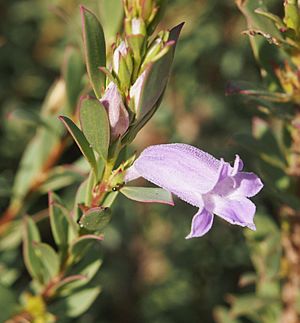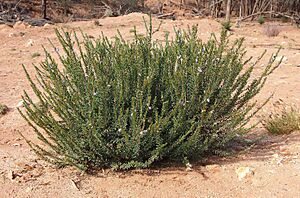Dolomite fuchsia bush facts for kids
Quick facts for kids Dolomite fuchsia bush |
|
|---|---|
 |
|
| Scientific classification | |
| Genus: |
Eremophila (plant)
|
| Species: |
christophori
|
The Dolomite Fuchsia Bush (scientific name: Eremophila christophori) is a beautiful flowering plant. It belongs to the figwort family, called Scrophulariaceae. This plant grows naturally only in the southern part of the Northern Territory in Australia. It's a tall bush with bright green leaves and flowers that can be white, pink, or lilac.
Contents
What Does the Dolomite Fuchsia Bush Look Like?
The Dolomite Fuchsia Bush is an upright shrub. It usually grows up to 2.5 meters (about 8 feet) tall. It can also spread out to 2 meters (about 6.5 feet) wide.
Its leaves grow one after another along the stems. They often overlap each other. The leaves are shaped like an oval or a spear. They are usually 10.5 to 25 millimeters (about 0.4 to 1 inch) long. They are about 2.5 to 7 millimeters (about 0.1 to 0.3 inches) wide. Most leaves are smooth and bright green. Sometimes, they might have a faint purple color.
The flowers grow one by one where the leaves meet the stem. They don't have a stalk. There are 5 thin, green sepals. The top sepal is very small. The other 4 sepals are 4 to 8 millimeters (about 0.16 to 0.3 inches) long and overlap.
The petals are 18 to 30 millimeters (about 0.7 to 1.2 inches) long. They join together at the bottom to form a tube. This petal tube can be white, blue, or a shade of pink to lilac. The outside of the tube has short hairs. The inside is full of thin, spidery hairs.
This plant flowers for most of the year. But it blooms mostly in spring and mid-summer. After flowering, it produces fruits. These fruits are dry and shaped like an oval or a cone. They look wrinkled and are 5 to 8.5 millimeters (about 0.2 to 0.3 inches) long.
How Was the Dolomite Fuchsia Bush Named?
The scientific name Eremophila christophori was first officially described in 1875. This was done by a famous botanist named Ferdinand von Mueller. He published his description in a book called Fragmenta phytographiae Australiae.
The second part of the name, christophori, honors Christopher Giles. He was the person who collected the first example of this plant for scientific study. This first example is called the "type specimen."
Where Does the Dolomite Fuchsia Bush Grow?
This type of eremophila plant grows in a specific area. This area stretches from the MacDonnell Ranges (west of Alice Springs) towards the border with Queensland.
It likes to grow in sandy soils. Often, these soils are found over laterite (a type of soil rich in iron and aluminum) or limestone. You can find it on low hills in these areas.
Is the Dolomite Fuchsia Bush Protected?
The Northern Territory Parks and Wildlife Conservation Act lists Eremophila christophori as "of least concern." This means that currently, there are plenty of these plants in the wild. They are not considered to be in danger of disappearing.
Growing the Dolomite Fuchsia Bush in Gardens
The Dolomite Fuchsia Bush is a great plant for gardens. It almost always has flowers! It's a tough plant, and some have grown in gardens for over 30 years.
You can grow new plants from cuttings. Or, you can graft them onto another plant called Myoporum. This plant prefers soil that drains water well. However, it can also grow in heavier soils. In heavier soils, it might become a more open-looking plant.
It can handle dry conditions (drought hardy). It also tolerates light frost. If you plant it in well-drained soil in a sunny spot, it will grow quickly.


